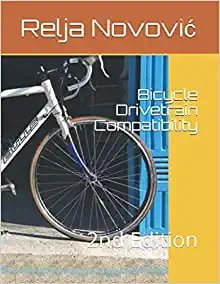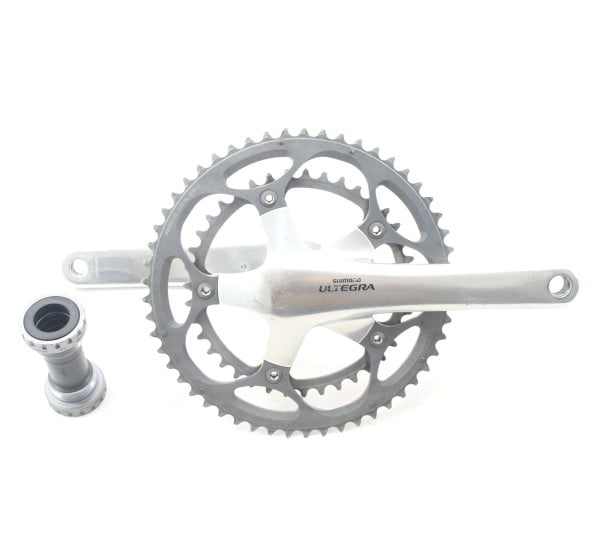This post addresses bicycle crankset compatibility in terms of mixing various speed cranksets with other components. For example: an 8 speed crankset on a bicycle with 10 rear sprockets and a 10 speed chain (a), or a triple chainring with a front derailleur (FD) constructed for double chainrings (b). It will also address mixing road cranksets with MTB FDs and vice versa (c).
Before you start, to avoid any misunderstanding:
please take the 5 minutes needed to read the compatibility articles use instructions.
Separate posts explain: standards of bottom bracket (crankset) bearings (and axles), as well as bottom bracket compatibility). That will not be taken into consideration in this post, but when acquiring a crankset, make sure that it’s bottom bracket (BB) standard is one that can be mounted on the bicycle frame.
In the post about FD compatibility, other factors important when matching FD and crankset are described. So, even if number of speeds and type of crankset and FD are the same, those factors should also be matched. In short: FD cage shape and number of large chainring teeth it is designed for should match the teeth number of the largest chainring on the crankset it is combined width. Detailed explanation of things one should pay attention to and try to match are listed in the post:
Compatibility – front derailleurs
1. Different number of speeds for crankset, and the cassette
Typical example: can a crankset for 9 speeds be used with a bicycle that has 11 speeds (rear sprockets) and an 11 speed chain (for 11 sprockets)? Or vice versa: can a 10 speed crankset be used on a bicycle with 8 speeds?
All the “speed” chains have almost the same inner diameter (roller width). Despite the fact that chains for more speeds have thinner plates and are therefore narrower (on the outside) than chains for less speeds, the inner width is the same. For detailed explanation look here: Compatibility – chains.
Because of this, teeth thickness of crankset chainrings doesn’t vary much. Also, adjacent crankset chainrings have great difference in diameter and are not as tightly spaced as rear sprockets. So there is no risk of chain, being to wide, to get stuck between two chainrings.
All this enables crankset chainrings to be freely combined with all kinds of chains (and, over the chain, various numbers of rear sprockets). The only complication is the thinner cage of the FDs designed for more speeds. This means, if using a (wider) chain for less speeds, chain will rub the cage with less cross chaining then if a wider cage FD was used. Cross chaining is not advisable anyway, so one can consider this and early(er) warning. Explanation of gear changing and cross chaining is here:
Bicycle gear ratios
Exceptions to this are single speed chainrings, made for wider, 1/8″ thick chains (they won’t work with multi-speed chains) and Shimano IG chainrings (that work only with chains for up to 8 speeds).
2. Mix-matching various types of cranks (chainrings)
2.1. Combining double chainring cranksets with triple FDs
Explanation of important attributes and differences of FDs can be found in these posts:
Front derailleur
Compatibility – front derailleurs
Triple FD has a longer cage (than a double FD), with inner part of the cage being a bit lower, to catch the chain off the third, smallest chainring. If the two chainrings of a double don’t have a big difference in number of teeth (14 or less), triple FD should work just fine on a double (with correct setup of the limit screws and cable, of course). Typical examples are standard road doubles 53-39 (14 teeth), or 46-36 (10 teeth) – a typical cyclo-cross crankset.
If using a popular “compact” crankset, with a large difference in number of teeth between the big and the small chainring, like 50-34 (16 teeth), or 46-30, shifting will be slower, with more possibility of dropping the chain when shifting onto the smaller chainring.
However, even if chainring difference is large, front shifts are usually quite rare (compared to rear shifts), so even then it might work acceptably well (depending on one’s criteria).
2.2. Combining triple chairing cranksets with double FDs
The biggest problem with this combo is that double FDs don’t have a long enough cage, with inner part lowered enough to catch the chain off the smallest, third chainring.
The quality of this pair functioning is affected by the following two factors:
- The lower the difference in teeth number between the largest and the smallest chainring, the better.
For example: 48-38-28 (20 teeth difference) is better than 44-32-22 (22 teeth difference).
Or: 50-39-30 (20 teeth difference) is better than 53-42-30 (23 teeth difference). - The number of large chainring teeth the FD is designed for should match the number of teeth of the largest triple chainring, or be slightly lower.
For example: FD for 50 tooth chainring on a 50-39-30 triple.
Or a FD for a 46 tooth chainring on a 48-38-28 double.
Bad idea is a FD for a 53 tooth chainring on a 44-32-22 triple.
2.3. Combining MTB cranksets with road FDs and vice versa
Road and MTB cranksets have slightly different chainring spacing. Still, this doesn’t cause much problems even to shifters and FDs when mixing them, as is explained in these two posts:
Compatibility – front shifters
Compatibility – front derailleurs
Difference definitely doesn’t bother the FDs. If the shifter, cable and screws for limiting movement are properly set, there won’t be any problems.
Related post – Bottom bracket compatibility:

Compatibility posts are also available in eBook (printable and Kindle) and paperback editions on Amazon:

If you have any questions (or additions and corrections), please use the BikeGremlin forum’s compatibility section:
https://www.bikegremlin.net/forums/bike-compatibility/
The existing comments posted under this article (questions and answers) have been moved to this BikeGremlin forum thread:
https://www.bikegremlin.net/threads/compatibility-09-cranks-ets-article-comments.119/


Hi Relja,
I didn’t know that road and mountain cranks have different spacing between chain rings. Any technical reason for this or just a deliberate attempt to make this less generic and compatible?
I have a doubt about chain ring spacing, has it changed over time as more speeds were added to drive trains? Sprocket spacing was the same up to 8 speeds, then sprockets get closer with every new sprocket added, but what about chain rings?
I want to recycle a triple crankset shimano DX from a 7 speed drivetrain, would it work fine with a modern 3×9 speed indexed shifter?
Friction shifters don’t have any problem, it may be the way to go.
Thanks
As for sprockets, that too has varied from the start (6, 7…). See the post about cassette compatibility, or cassette standards.
For cranks, manufacturers claim they aren’t compatible, but I’ve had good results mix-matching MTB ones with road shifters and derailleurs and vice-versa.
Hi, Relja.
I have a Shimano Claris 2×8 system and wonder if i can keep the 8s chainset from Claris and upgrade the rest to 10s Tiagra, including chaing.
People told me that i can face problems with the bigger space between chain rings of Claris compared with Tiagra chainset.
Thanks.
Switching to the 10 speed Tiagra would require you replace shifters, derailleurs, chain and cassette. You could keep the cranks (front chainrings), they will probably work OK, not perfectly, but OK.
hi, may i know can i use a 4700 tiagra or 105 crankset with my stock 8 speed shimano cassette & the stock 8 speed chain? the setup will be 1 x 8 without fd, and i will be only using the outer 52t chainring, mainly just because i like the looks of the crankset.
With such setup (I suppose using the outer chanring of a double set), the front chainring will be very far out – not sitting in the middle of the cassette.
So, when using the lowest gear, the chain will be at a great angle (“cross chaining”). 1x setups are far from perfect, even when the front chainring sits right in the middle of the cassette.
Whether that will pose a problem, or not, it depends on the frame’s chainstay length as well (the longer it is, the less of a problem it will be).
Yeah i understand the cross chain effect, but thats how my folding bike comes with 1 x 8 setup with square taper bb. So it is possible to use 8 speed chain on a 10 speed tiagra crankset right ?
Since you are using the larger ring, there is no risk of the chain rubbing it (using the smaller might require also using a narrower chain to avoid that – depending on the chainline, of course).
With this setup, since the chain pitch and its inner width are the same, I don’t see why it should not work. That is – in terms of chainring compatibility. Though 1x setups are always tricky. Clutch rear derailleurs and narrow-wide chainrings were made to help those setups be less problematic.